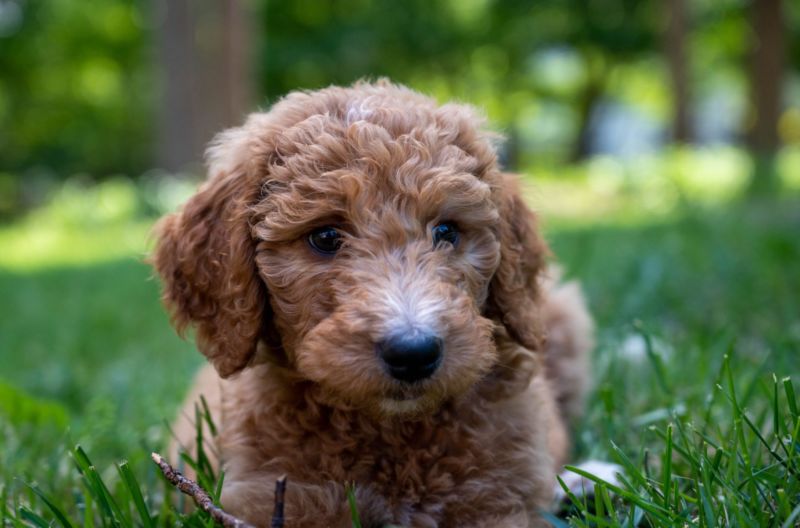Goldendoodles are a unique hybrid breed that offers variety in size and color. In addition to the color variances, the visually stunning coat that adorns most doodles and their sweet personalities make them an easy breed to love.
Determining the optimal color of your doodle starts with a conversation with goldendoodle breeders. One of the best parts about a crossbreed like this one is choosing from a wide array of color types.

What Is a Goldendoodle?
Goldendoodles are hybrid breeds of poodles and golden retrievers. Combining these two breeds creates a mild-mannered pup with minimal shedding and a lovable disposition. Goldendoodles are people pleasers that constantly seek affection and approval from their owners. This means they’re perfect family dogs, especially for those who are active and spend plenty of time outdoors.
The golden retriever element of the goldendoodle’s lineage is responsible for the working portion of its disposition. As such, goldendoodles make for excellent service or therapy dogs. The playful poodle element of its lineage also contributes to its beauty.
Common Goldendoodle Colors
Doodle owners delight in choosing the option they desire, from black or gray to cream and apricot hues. One of the exciting aspects of doodle coloring is that the face, paw pads and other physical features almost always stand out in striking ways because of the color contrasts of these pups.
Gray Goldendoodles
Gray goldendoodles typically derive their silver-hued coat from their poodle ancestors. Goldendoodle gray is a more rustic version of the silver coloring of poodles and may not surface fully until six weeks after a goldendoodle puppy is born.
It typically only occurs in multigenerational breeding situations. As these pups age, they may have a two-toned coat, as the fur around their face and paw pads may retain the color longer. This means that some gray doodles end up with a blue or gray color to their coats.
Parti Goldendoodles
The parti goldendoodle color mixes white and any other color, though this is commonly an apricot or tan shade. The parti coloring is a rare goldendoodle outcome, but it can happen. It’s due to a recessive gene that modifies solid-colored goldendoodle coats.
The exciting thing about this color pattern is that no two parti goldendoodles are precisely the same. Even if the parti goldendoodle’s colors are the same, the pattern will be distinct.
Black Goldendoodles
Black goldendoodles are actually pretty rare. Interestingly, it’s not one of the commonly requested colors among doodle owners, perhaps because it doesn’t perpetuate the teddy bear look many doodle lovers seek.
One of the unique aspects of a black goldendoodle is that everything on the pup is dark in hue: facial features, foot pads and eyes. Both dogs from which a black goldendoodle has been bred must also carry the recessive “Black-Gel” gene. This makes it challenging to achieve this result in a first-generation goldendoodle puppy.
Another point of note for black doodles is that the fading can be significant. What starts out as a rich black coat can become a gray, silver or even blue hue once the dog is past its puppy stage.
Apricot Goldendoodles
The apricot goldendoodle is one of the most popular colors of this breed. Apricot doodles typically have black features, including eyes and toenails, making their coat’s apricot hue stand out even more.
Apricot is one of the red variations for goldendoodles, which is part of the reason it’s such a sought-after result. This color comes largely from the golden retriever lineage of a doodle. An apricot goldendoodle coat tends to make the pup look like a teddy bear, which is just one of the reasons doodle lovers seek this coat hue.
Like other doodle colors, it does start off darker at first, lightening over time. In fact, an apricot goldendoodle coat can lighten considerably. After a while, apricot goldendoodle puppies tend to be confused with cream or tan versions of this breed.
Chocolate Goldendoodles
Solid chocolate is another standard goldendoodle color. Chocolate goldendoodles owe their lush coat color to a recessive gene that would otherwise create a rich black fur coat. This means the puppy in question must inherit one recessive gene from each of its parents to end up with a chocolate hue.
Chocolate goldendoodle puppies are born with a dark brown coat that lightens over time. Therefore, some brown goldendoodles may have a lighter shade more quickly than others. This lightening actually begins at the six-week mark and may be most noticeable around their muzzles and in the area around their paw pads.

Cream Goldendoodles
Interestingly, cream-colored pups are variations of the red line of this breed. They’re sometimes confused with white doodles because of how light the cream can get over time. Cream goldendoodle coats have the most extensive color variation in tones and dark points of all goldendoodles. This is another color derived from the golden retriever lineage of a goldendoodle puppy.
Cream doodles tend to either have dark or pink features and paw pads. Cream goldendoodles are commonly used for breeding other color variations within this breed, such as parti goldendoodles.
Abstract Goldendoodles
This is one of the most interesting coloring combinations because, similar to the parti version of this breed, no two abstract goldendoodle coats will look the same. What makes a goldendoodle puppy abstract in terms of color is the presence of a dominant color mixed with touches of white somewhere on the pup’s coat.
Typically, these white areas will be found on the face or on the chest and paw areas of the puppy fur. They are not large swaths of white, which makes the color stand out all the more.
Blue Goldendoodles
Blue goldendoodles are extremely rare because of the nature of the recessive genes that cause this hue. It takes multiple generations of goldendoodle breeding to achieve a blue tint, which is why blue goldendoodle dogs are coveted by doodle lovers. They may appear to have a gray coat at first. However, upon closer inspection, the darker, steely hue of the blue is more evident.
These pups are also born dark at first, and as their coat lightens, the blue hue becomes more apparent. Only a few goldendoodle dogs will remain blue once they have adult coats. Most will see their coats clear to a gray later in life.
There’s no way to predict which dogs will experience this loss of blue hue and which may retain it.
Goldendoodle Coats Change Color
Do goldendoodles change color as they get older? Over time, a goldendoodle’s puppy coat lightens as it ages. Depending on the parents, it may have some variations in color on its tails and ears. This comes from the poodle component of the gene pool, as poodle fur tends to change over time. This typically starts at age three in poodles, which is one of the reasons it happens in goldendoodles once the dog is past the puppy stage.
The extent to which the coat changes color depends on the original hue. Cream, for instance, is likely to fade less obviously over time than one of the richer colors, like chocolate. There’s no way to avoid this process as it’s part of this breed’s maturation process. However, your breeder should give you an idea of the extent to which the goldendoodle dog’s hair and fur color will fade over time and what general color to expect depending on the pup’s lineage.
